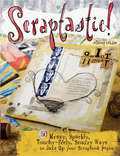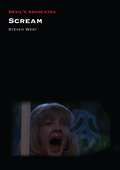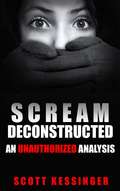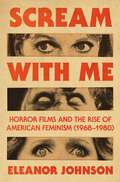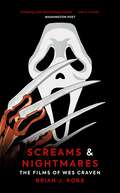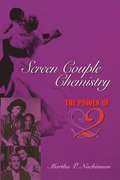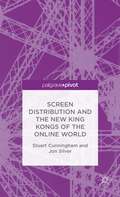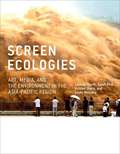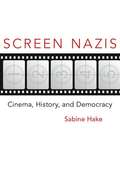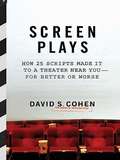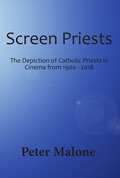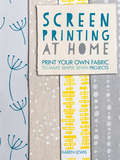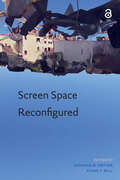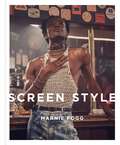- Table View
- List View
Scraptastic!: 50 Messy, Sparkly, Touch-Feely, Snazzy Ways to Jazz Up Your Scrapbook Pages
by Ashley CalderJazz up your pages!Get ready to infuse your scrapbook layouts with messy, sparkly, snazzy and exciting new techniques. Go beyond the usual—experiment with art supplies, try unfamiliar tools, go wild and have fun. With Scraptastic! you can take your projects to the next level using innovative ideas for creating playful and artistic pages.Inside you will find 50 illustrated techniques for jazzing up your layouts. Step-by-step photos, complete supply lists and easy-to-follow instructions show you exactly how to create each surprisingly easy project. Plus, you'll find helpful tips and tricks for creating cards as well as getting the most out of your supplies.Grab your tools and try:· watercolor· golf leafing· stamping· embroidery· hand-cut lettering· paper piecing· beading· collage· quilting· and more!Whether you're an art novice or design veteran, let Scraptastic! be your guide to discovering the messy, sparkly, touchy-feely, snazzy world of scrapbooking.
Scratchin' and Survivin': Hustle Economics and the Black Sitcoms of Tandem Productions
by Adrien SebroThe 1970s was a golden age for representations of African American life on TV sitcoms: Sanford & Son, Good Times, The Jeffersons. Surprisingly, nearly all the decade’s notable Black sitcoms were made by a single company, Tandem Productions. Founded by two white men, the successful team behind All in the Family, writer Norman Lear and director Bud Yorkin, Tandem gave unprecedented opportunities to Black actors, writers, and producers to break into the television industry. However, these Black auteurs also struggled to get the economic privileges and creative autonomy regularly granted to their white counterparts. Scratchin’ and Survivin’ discovers surprising parallels between the behind-the-scenes drama at Tandem and the plotlines that aired on their sitcoms, as both real and fictional African Americans devised various strategies for getting their fair share out of systems prone to exploiting their labor. The media scholar Adrien Sebro describes these tactics as a form of “hustle economics,” and he pays special attention to the ways that Black women—including actresses like LaWanda Page, Isabel Sanford, and Esther Rolle—had to hustle for recognition. Exploring Tandem’s complex legacy, including its hit racially mixed sitcom Diff’rent Strokes, he showcases the Black talent whose creative agency and labor resilience helped to transform the television industry.
Scratching the Surface: Adventures in Storytelling (Painted Turtle)
by Harvey OvshinskyScratching the Surface: Adventures in Storytelling is a deeply personal and intimate memoir told through the lens of Harvey Ovshinsky’s lifetime of adventures as an urban enthusiast. He was only seventeen when he started The Fifth Estate, one of the country’s oldest underground newspapers. Five years later, he became one of the country’s youngest news directors in commercial radio at WABX-FM, Detroit’s notorious progressive rock station. Both jobs placed Ovshinsky directly in the bullseye of the nation’s tumultuous counterculture of the 1960s and 70s. When he became a documentary director, Ovshinsky’s dispatches from his hometown were awarded broadcasting’s highest honors, including a national Emmy, a Peabody, and the American Film Institute’s Robert M. Bennett Award for Excellence. But this memoir is more than a boastful trip down memory lane. It also doubles as a survival guide and an instruction manual that speaks not only to the nature of and need for storytelling but also and equally important, the pivotal role the twin powers of endurance and resilience play in the creative process. You don’t have to be a writer, an artist, or even especially creative to take the plunge, Ovshinsky reminds his readers. "You just have to feel strongly about something or have something you need to get off your chest. And then find the courage to scratch your own surface and share your good stuff with others." Above all, Ovshinsky is an educator, known for his passionate support of and commitment to mentoring the next generation of urban storytellers. When he wasn’t teaching screenwriting and documentary production in his popular workshops and support groups, he taught undergraduate and graduate students at Detroit’s College for Creative Studies, Wayne State University, Madonna University, and Washtenaw Community College. "The thing about Harvey," a colleague recalls in Scratching the Surface, "is that he treats his students like professionals and not like newbies at all. His approach is to, in a very supportive and non-threatening way, combine both introductory and advanced storytelling in one fell swoop."
Scream (Devil's Advocates)
by Steven WestWes Craven's Scream (1996) emerged at the point where the early eighties American slasher cycle had effectively morphed into the post-Fatal Attraction trend for Hollywood thrillers that incorporated key slasher movie tropes. Scream emerged as a spiritual successor to Wes Craven's unpopular but critically praised previous film New Nightmare (1994), which evolved from his frustration at having lost creative control over his most popular creation, Freddy Krueger, and rebirthed the character in a postmodern context. Scream appropriates many of the concepts, conceits, and in-jokes inherent in New Nightmare, albeit in a much more commercial context that did not alienate teenage audiences who were not around to see the movies that were being referenced. This Devil's Advocate offers a full exploration of Scream, including its structure, its many reference points (such as the prominent use of Halloween as a kind of sacred text), its marketing ("the new thriller from Wes Craven" – not a horror film), and legacy for horror cinema in the new millennium.
Scream All Night
by Derek MilmanA darkly hilarious contemporary realistic young adult novel about growing up and finding your place in the world, perfect for fans of Me and Earl and the Dying Girl and Running With Scissors. Goodreads The Hottest YA Books of Summer * B&N Teen Blog Most Anticipated YA Debuts of 2018 * Buzzfeed 27 YA Books You’ll Want to Devour By the Pool This Summer *DARIO HEYWARD KNOWS ONE THING: He’s never going back to Moldavia Studios, the iconic castle that served as the set, studio, and home to the cast and crew of dozens of cult classic B-horror movies. It’s been three years since Dario’s even seen the place, after getting legally emancipated from his father, the infamous director of Moldavia’s creature features.But then Dario’s brother invites him home to a mysterious ceremony involving his father and a tribute to his first film—The Curse of the Mummy’s Tongue. Dario swears his homecoming will be a one-time visit. A way for him to get closure on his past—and reunite with Hayley, his first love and costar of Zombie Children of the Harvest Sun, a production fraught with real-life tragedy—and say good-bye for good. But the unthinkable happens—Dario gets sucked back into the twisted world of Moldavia and the horrors, both real and imagined, he’s left there.With only months to rescue the sinking studio and everyone who has built their lives there, Dario must confront the demons of his past—and the uncertainties of his future. But can he escape the place that’s haunted him his whole life?
Scream Deconstructed: An Unauthorized Analysis
by Scott KessingerSomeone's taken their love of Scream one step too far. . . and written a book about it! Having earned the respect and accolades of critics and audiences, generated more than half a billion dollars in revenue, and inspired a gaggle of imitators, it's safe to say Scream is millions of people's favorite scary movie. While the Scream films have scared and entertained moviegoers worldwide, they've also invited us to closer examine the movies we watch: to deconstruct them. This book aims to do just that. Scream Deconstructed: An Unauthorized Analysis puts all four Scream movies under the knife to examine the meaning, themes and philosophy of the movie series that brought horror back from the dead by breaking all the rules. Take a close look into the heart of this pop culture phenomenon and what its characters - including Sidney, Gale, Dewey, and each film's killer - represent. Find out what reality, film, fantasy, and sex have to do with it all. Scream Deconstructed is sure to please any fan of Scream, horror, or film in general.
Scream with Me: Horror Films and the Rise of American Feminism (1968-1980)
by Eleanor JohnsonA LOS ANGELES TIMES MOST ANTICIPATED BOOK OF 2025 A compelling, intelligent, and timely exploration of the horror genre from one of Columbia University&’s most popular professors, shedding light on how classic horror films demonstrate larger cultural attitudes about women&’s rights, bodily autonomy, and more.In May of 2022, Columbia University&’s Dr. Eleanor Johnson watched along with her students as the Supreme Court reversed Roe v. Wade. At the same time, her class was studying the 1968 horror film Rosemary&’s Baby and Johnson had a sudden epiphany: horror cinema engages directly with the combustive politics of women&’s rights and offer a light through the darkness and an outlet to scream. With a voice as persuasive as it is insightful, Johnson reveals how classics like Rosemary&’s Baby, The Exorcist, and The Shining expose and critique issues of reproductive control, domestic violence, and patriarchal oppression. Scream with Me weaves these iconic films into the fabric of American feminism, revealing that true horror often lies not in the supernatural, but in the familiar confines of the home, exposing the deep-seated fears and realities of women&’s lives. While on the one hand a joyful celebration of seminal and beloved horror films, Scream with Me is also an unflinching and timely recognition of the power of this genre to shape and reflect cultural dialogues about gender and power.
Screams & Nightmares: The Films of Wes Craven
by Brian J. RobbWriter, producer, and director Wes Craven has successfully tapped into the horror vein for over forty years, serving up scary, funny, cutting-edge thrillers that have become classics in the genre. His films have been both critical and commercial successes, most notably Nightmare on Elm Street, which spawned a series of sequels and made Craven (and his creation, Freddy Kruger) an international sensation. He then created a second indelible series in the horror movie trope with Scream. In Screams & Nightmares, Brian J. Robb examines Craven's entire career, from his low-budget beginnings to his most recent box office hits, from the banned thriller The Last House on the Left and the cult classic The Hills Have Eyes to the outrageous Shocker and The People Under the Stairs. Through exclusive interviews with Craven, Robb provides in-depth accounts of the making of each of the films – including the final installments of the Scream series – Craven's foray into writing novels, and his numerous television projects.
Screen Adaptation: A Scriptwriting Handbook
by Kenneth PortnoyScreen Adaptation : A Scriptwriting Handbook, 2nd ed. examines the challenge screenwriters face when adapting novels, plays, and short stories for the screen. Thoroughly updated to include new exercises and example from current films, this book provides practical, usable information on how to find the best plot line for a script, choose key characters, and understand the goals and formats of different genres. Topics include: determining which characters and events are most valuable on developing the main story;expanding short novellas and condensing long novels;using dialog to advance the story and reveal character;comparing the formats of plays, short stories, and novels to those of screenplaysapproaching the marketplaceIn this book, both beginning writers and professionals will find the tools necessary to evaluate a prospective source and create a successful screenplay
Screen Adaptation: Techniques for Adapting Books, Comics and Real-Life Stories into Screenplays
by Eric R. WilliamsOnce you understand the basics of screenwriting, ideas for your next screenplay are everywhere. Whether it comes from a favorite children’s book, a summer novel you discover accidentally, a news story that catches your imagination, or a chapter from your own life — advanced screenwriting strategies should now guide you through your first adaptation. In Screen Adaptation: Beyond the Basics, award-winning screenwriter Eric Williams uses examples from award-winning screenplays to explain new storytelling techniques. His real-world examples illustrate a range of advanced approaches — including new ways to identify and craft tension, how to reimagine structure and character, and how to strengthen emotional depth in your characters and in the audience. Screen Adaptation: Beyond the Basics teaches readers new ways to engage with source material in order to make successful adaptation decisions, regardless of the source material. The book offers: Three detailed examples of award-winning adaptations by the author, including the complete short story and final scripts used in the Voices From the Heartland project; Breakout boxes highlighting modern and historical adaptations and providing examples for each concept discussed in the book; More than fifty charts providing easy-to-use visual representations of complex concepts; New screenwriting techniques developed by the author, including the Triangle of Knowledge, the Storyteller’s Parallax, and the idea of Super Genres as part of a Screenwriters Taxonomy.
Screen Comedy and Online Audiences (Routledge Research in Cultural and Media Studies)
by Inger-Lise Kalviknes BoreThe question of why we laugh (or don't laugh) has intrigued scholars since antiquity. This book contributes to that debate by exploring how we evaluate screen comedy. What kinds of criteria do we use to judge films and TV shows that are meant to be funny? And what might that have to do with our social and cultural backgrounds, or with wider cultural ideas about film, TV, comedy, quality and entertainment? The book examines these questions through a study of audience responses posted to online facilities such as Twitter, Facebook, review sites, blogs and message boards. Bore’s analysis of these responses considers a broad range of issues, including how audiences perceive the idea of "national" comedy; what they think of female comedians; how they evaluate romcoms, sitcoms and web comedy; what they think is acceptable to joke about; what comedy fans get excited about; how fans interact with star comedians; and what comedy viewers really despise. The book demonstrates some of the ways in which we can adapt theories of humour and comedy to examine the practices of contemporary screen audiences, while offering new insights into how they negotiate the opportunities and constrictions of different online facilities to share their views and experiences.
Screen Couple Chemistry
by Martha P. NochimsonAstaire and Rogers, Tracy and Hepburn. Just the mention of their names evokes the powerful chemistry between these screen couples, which utterly transcended the often formulaic films in which they appeared together. Indeed, watching the synergistic flow of energy between charismatic screen partners is one of the great pleasures of cinema and television, as well as an important vehicle for thinking through issues of intimacy and gender relations. In this book, Martha P. Nochimson engages in a groundbreaking study of screen couple chemistry. She begins by classifying various types of couples to define what sets the synergistic couple apart from other onscreen pairings. Then she moves into extended discussions of four enduring screen couples-Maureen O'Sullivan/Johnny Weissmuller, Myrna Loy/William Powell, Fred Astaire/Ginger Rogers, and Katharine Hepburn/Spencer Tracy. Using theories of neuroscience, she demonstrates that their onscreen chemistry is a very real phenomenon, powerful enough to subvert conventional formulations of male/female relations. Material she has uncovered in the infamous Production Code Administration files illuminates the historical context of her contentions. Finally, Nochimson traces the screen couple to its present-day incarnation in such pairs as Woody Allen/Diane Keaton, Scully/Mulder of The X-Files, and Cliff/Claire Huxtable of The Cosby Show.
Screen Culture and the Social Question, 1880–1914 (KINtop #3)
by Ludwig Vogl-Bienek and Richard CrangleEssays exploring how reformers and charities used the “magic lantern” to raise public awareness of poverty.Public performances using the magic or optical lantern became a prominent part of the social fabric of the late nineteenth century. Drawing on a rich variety of primary sources, Screen Culture and the Social Question, 1880-1914 investigates how the magic lantern and cinematograph, used at public lectures, church services, and electoral campaigns, became agents of social change.The essays examine how social reformers and charitable organizations used the “art of projection” to raise public awareness of the living conditions of the poor and the destitute, as they argued for reform and encouraged audiences to work to better their lot and that of others.
Screen Distribution and the New King Kongs of the Online World
by Stuart Cunningham Jon SilverDrawing on comparisons with historical shake-ups in the film industry, Screen Distribution Post-Hollywood offers a timely account of the changes brought about in global online distribution of film and television by major new players such as Google/YouTube, Apple, Amazon, Yahoo , Facebook, Netflix and Hulu.
Screen Ecologies: Art, Media, and the Environment in the Asia-Pacific Region
by Linda Williams Sarah Pink Larissa Hjorth Kristen SharpImages of environmental disaster and degradation have become part of our everyday media diet. This visual culture focusing on environmental deterioration represents a wider recognition of the political, economic, and cultural forces that are responsible for our ongoing environmental crisis. And yet efforts to raise awareness about environmental issues through digital and visual media are riddled with irony, because the resource extraction, manufacturing, transportation, and waste associated with digital devices contribute to environmental damage and climate change. Screen Ecologies examines the relationship of media, art, and climate change in the Asia-Pacific region -- a key site of both environmental degradation and the production and consumption of climate-aware screen art and media.Screen Ecologies shows how new media and visual artists provide alternative ways for understanding the entanglements of media and the environment in the Asia-Pacific. It investigates such topics as artists' exploration of alternative ways to represent the environment; regional stories of media innovation and climate change; the tensions between amateur and professional art; the emergence of biennials, triennials, and new arts organizations; the theme of water in regional art; new models for networked collaboration; and social media's move from private to public realms. A generous selection of illustrations shows a range of artist's projects.
Screen Ecologies: Art, Media, and the Environment in the Asia-Pacific Region (Leonardo)
by Linda Williams Sarah Pink Larissa Hjorth Kristen SharpHow new media and visual artists provide alternative ways for understanding and visualizing the entanglements of media and the environment in the Asia-Pacific.Images of environmental disaster and degradation have become part of our everyday media diet. This visual culture focusing on environmental deterioration represents a wider recognition of the political, economic, and cultural forces that are responsible for our ongoing environmental crisis. And yet efforts to raise awareness about environmental issues through digital and visual media are riddled with irony, because the resource extraction, manufacturing, transportation, and waste associated with digital devices contribute to environmental damage and climate change. Screen Ecologies examines the relationship of media, art, and climate change in the Asia-Pacific region—a key site of both environmental degradation and the production and consumption of climate-aware screen art and media.Screen Ecologies shows how new media and visual artists provide alternative ways for understanding the entanglements of media and the environment in the Asia-Pacific. It investigates such topics as artists' exploration of alternative ways to represent the environment; regional stories of media innovation and climate change; the tensions between amateur and professional art; the emergence of biennials, triennials, and new arts organizations; the theme of water in regional art; new models for networked collaboration; and social media's move from private to public realms. A generous selection of illustrations shows a range of artist's projects.
Screen Hustles, Grifts and Stings: Stings, Grifts, Hustles and the Long Con
by A. SargeantScreen Hustles, Grifts and Stings identifies recurrent themes and techniques of the con film, suggests precedents in literature and discusses the perennial appeal of the con man for readers and viewers alike. Core studies span from film (Catch Me If You Can, Paper Moon, House of Games) to television (Hustle), from Noir (The Grifters) to Romantic Comedy (Gambit). Frequently, the execution of the con is only finely distinguishable from the conduct of a legitimate profession and, challengingly, a mark is often shown to be culpable in his or her undoing. The best con films, it is suggested, invite re-watching and reward the viewer accordingly: who is complicit and when? How and where is the con achieved? When is the viewer party to the con? And what, if any, moral is to be drawn?
Screen Media: Analysing Film and Television
by Jane Stadler Kelly McWilliamScreen Media offers screen enthusiasts the analytical and theoretical vocabulary required to articulate responses to film and television. The authors emphasise the importance of 'thinking on both sides of the screen'. They show how to develop the skills to understand and analyse how and why a screen text was shot, scored, and edited in a particular way, and then to consider what impact those production choices might have on the audience.Stadler and McWilliam set production techniques and approaches to screen analysis in historical context. They demystify technological developments and explain the implications of increasing convergence of film and television technologies. They also discuss aesthetics, narrative, realism, genre, celebrity, cult media and global screen culture. Throughout they highlight the links between screen theory and creative practice.With extensive international examples, Screen Media is an ideal introduction to critical engagement with film and television.'Screen Media offers a systematic approach to film and television analysis. The examples chosen by the authors are both appropriate and timely, and are presented in a very lively and readable form that will appeal to an international readership.' - Rebecca L. Abbott, Professor of Film, Video + Interactive Media, Quinnipiac University, USA
Screen Nazis
by Sabine HakeFrom the late 1930s to the early twenty-first century, European and American filmmakers have displayed an enduring fascination with Nazi leaders, rituals, and symbols, making scores of films from Confessions of a Nazi Spy (1939) and Watch on the Rhine (1943) through Des Teufels Gentral (The Devil's General, 1955) and Pasqualino settebellezze (Seven Beauties, 1975) up to Der Untergang (Downfall, 2004), Inglourious Basterds (2009), and beyond.
Screen Plays: How 25 Scripts Made It to a Theater Near You--for Better or Worse
by David S. CohenIn this fascinating survey of contemporary screen craft, David Cohen of Script and Variety magazines leads readers down the long and harrowing road every screenplay takes from idea to script to screen. In interviews with Hollywood screenwriters from across the board-Oscar winners and novices alike-Cohen explores what sets apart the blockbuster successes from the downright disasters. Tracing the fortunes of twenty-five films, including Troy, Erin Brockovich, Lost in Translation, and The Aviator, Cohen offers insider access to back lots and boardrooms, to studio heads, directors, and to the over-caffeinated screenwriters themselves. As the story of each film evolves from the drawing board to the big screen, Cohen proves that how a script is written, sold, developed, and filmed can be just as dramatic and intriguing as the movie itself-especially when the resulting movie is a fiasco. Covering films of all kinds-from tongue-in-cheek romps like John Waters's A Dirty Shame to Oscar winners like Monster's Ball and The Hours-Screen Plays is an anecdote-filled, often inspiring, always revealing look at the alchemy of the movie business. With Cohen as your expert guide, Screen Plays exposes how and why certain films (such as Gladiator) become "tent poles," those runaway successes every studio needs to survive, and others become train wrecks. Full of critical clues on how to sell a script-and avoid seeing it destroyed before the director calls Action!-it's the one book every aspiring screenwriter will find irresistible.
Screen Priests: The Depiction of Catholic Priests in Cinema, 1900-2018
by Peter MaloneThere is never a shortage of priest characters on our screens. Even Spencer Tracy, Bing Crosby and Barry Fitzgerald won Oscars for playing priests. Robert de Niro has been ordained four times (including a bishop). Many stars have been eager to play priests, as have numerous supporting actors. The question arises: how have been priests portrayed over the decades? There have been kindly priests with their advice, stern priests who laid down the law, heroic priests on mission, in more recent years, priests who have been abusers. And there have been priests who were part of the scenery, especially at funerals. This is something of a comprehensive look at priests on screen, looking at portrayals from the late 19th century, over the decades, for 120 years. The films considered are mainly English-language but quite there are a number from other cultures. The book offers some Church background and developments, the range of films, a highlighting of a key film representing each decade. It also has separate chapters on Irish priests, Australian priests, exorcism priests and a chapter on films and abuse. There also Appendices on historical films, saint priests and popes. While one could read the book from cover to cover, it is mainly a book for reference. There are some detailed appreciations. There are some shorter considerations. Not everyone can see every film, not for want of trying! There are Indexes for exploring: film titles, directors, and actors who have played priests. Screen Priests is a fascinating historical look at films about Roman Catholic priests from the first until Martin Scorseses 2016 religious and cinematic masterpiece Silence. With the scope spanning decades and the breadth embracing films mostly from the United States, Britain, Ireland, Canada and Australia, the researcher will find a treasure trove and the film aficionado will relish Peter Malones encyclopedia knowledge and sometimes trivia of the world of priests on the silver screen.
Screen Printing at Home: Print Your Own Fabric to Make Simple Sewn Projects
by Karen LewisCreate hand-printed fabrics—and use them to make aprons, tote bags, and more! Do you love the idea of printing your own fabrics at home but don&’t know where to start? This comprehensive guide to screen printing shows you just how easy it is to create beautiful, hand-printed fabrics at your kitchen table. Screen printing expert Karen Lewis demonstrates two screen printing techniques—stenciling and screen filler—and how they can be used to create stunning, professional results with basic, inexpensive equipment. Both techniques are explained using step-by-step text and photography. Karen also explains how to create simple, sewn projects from your hand-printed fabrics. The sewing patterns include an apron, tote bag, and tea cozy, as well as ideas for how to print on ready-made items like tea towels to make delightful gifts for friends and family.
Screen Space Reconfigured (MediaMatters)
by Susanne Ø. Sœther Synne T. BullScreen Space Reconfigured is the first edited volume that critically and theoretically examines the many novel renderings of space brought to us by 21st century screens. Exploring key cases such as post-perspectival space, 3D, vertical framing, haptics, and layering, this volume takes stock of emerging forms of screen space and spatialities as they move from the margins to the centre of contemporary media practice. Recent years have seen a marked scholarly interest in spatial dimensions and conceptions of moving image culture, with some theorists claiming that a 'spatial turn' has taken place in media studies and screen practices alike. Yet this is the first book-length study dedicated to on-screen spatiality as such. Spanning mainstream cinema, experimental film, video art, mobile screens, and stadium entertainment, the volume includes contributions from such acclaimed authors as Giuliana Bruno and Tom Gunning as well as a younger generation of scholars.
Screen Style
by Marnie FoggScreen Style celebrates the beautiful, stylish and often covetable outfits and costumes featured in 50 iconic and diverse series of the small screen: from Mad Men to Call My Agent, Bridgerton to Empire.By organising the series into genres - Comedy, Coming of Age, Crime, Historical, Retro, Contemporary - the author shows how designers take different approaches when manipulating the latent power of dress to create convincing characters and enhance the experience of the viewer. She reveals how the characters themselves can become role models for what to wear, transforming actors into fashion influencers.The book is beautifully illustrated with over 250 screen stills, each accompanied by an extended caption, further demonstrating how TV series have helped to set the standard for fashion on and off screen.
Screen Style
by Marnie FoggScreen Style celebrates the beautiful, stylish and often covetable outfits and costumes featured in 50 iconic and diverse series of the small screen: from Mad Men to Call My Agent, Bridgerton to Empire.By organising the series into genres - Comedy, Coming of Age, Crime, Historical, Retro, Contemporary - the author shows how designers take different approaches when manipulating the latent power of dress to create convincing characters and enhance the experience of the viewer. She reveals how the characters themselves can become role models for what to wear, transforming actors into fashion influencers.The book is beautifully illustrated with over 250 screen stills, each accompanied by an extended caption, further demonstrating how TV series have helped to set the standard for fashion on and off screen.
